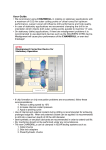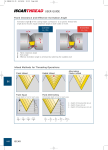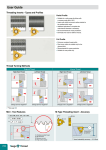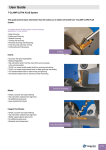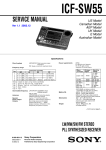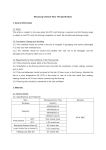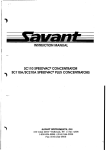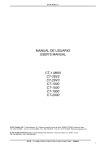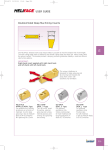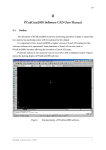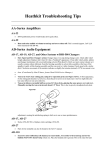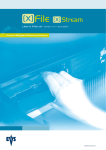Download User Guide • We recommend using CHAMDRILL in
Transcript
User Guide • We recommend using CHAMDRILL in rotating or stationary applications with a maximum of .0008” outer cutting points or chisel runout for optimum performance. Larger runout will influence drill performance and hole quality. • In case of stationary applications we recommend clamping the drill in an orientation which directs both outer cutting points parallel to machine “X” axis. • On stationary (lathe) applications, if there are misalignment problems it is recommended to use alignment devices such as the ISCAR/ETM GYRO device. Misalignment will cause poor performance of the CHAMDRILL or even tool breakage! GYRO Misalignment Correction Device for Stationary Operation T.I.R. max. .0008 Angular Adj. 1° Radial Adj. D.08 • If chip formation or chip evacuation problems are encountered, follow these recommendations: 1. Reduce cutting speed by 10% 2. Increase internal coolant pressure 3. Apply a pecking cycle • Use of internal and external coolant during drilling is recommended for achieving prolonged edge life. When only external coolant can be applied it is recommended to drill into a maximum depth of 2X the drill diameter. • Semi-synthetic or emulsion lubricants are recommended in order to extend tool life. • Dry machining should not be performed under any circumstances. • The new CHAMDRILLs can be clamped in ISCAR tooling systems such as: 1. Collet chucks 2. Side lock adapters 3. Power/hydraulic chucks • We recommend: - JET 2 collet chucks for internal and external coolant jets. - Using CHAMDRILL in SHORTIN adaptation with collets, for achieving higher tool life and improved performance. - Drilling sloped surfaces of a maximum 6°. Reduce feed by 30-50% when penetrating a sloped surface. Recommended exit surface angle is a maximum of 30°. In that case feed should be reduced by 30-50%. Sloped surfaces of more than 6° require spot or pre-hole centering to avoid drill deviation or poor drill performance. • Both options of stacked plate drilling are possible – with and without gap. (A minimum gap of .08” between plates is recommended). • Interrupted cut has direct influence on hole accuracy, quality and drill tool life. • CHAMDRILL can not be used on FITBORE or any other radial adjustment adaptation device. • Before clamping a new drilling head, apply some oil in the CHAMDRILL pocket. This practice reduces pocket wear and increases the number of indexing cycles. • Attached is a sketch which may help in identifying the indications of a worn-out drill head (see page 11). • A general troubleshooting guide is attached, for suggesting solutions to the most common problems. (See pages 14-15). DCM Indexable Head Drills Drilling Depth 3xD Range .866” to 1.020” L1 L2 L dh6 d1 D DCM øD (1) Range .866-.901 .906-.941 .945-.980 .984-1.020 L 2.60 2.71 2.83 2.95 Designation DCM 0866-260-100A-3D DCM 0906-272-100A-3D DCM 0945-283-100A-3D DCM 0984-295-100A-3D d 1.00 1.00 1.00 1.00 d1 1.26 1.26 1.26 1.26 L1 3.74 3.92 4.08 4.29 Hole tolerance: D+0.02 in average conditions, however, it can be higher or lower according to machine and tooling conditions. L2 2.20 2.20 2.20 2.20 Pocket Size 22 23 24 25 Key K DCM-22 K DCM-23 K DCM-24 K DCM-25 DCM Indexable Head Drills Drilling Depth 5xD Range .866” to 1.020” L1 L2 L dh6 d1 D DCM øD Range .866-.901 .906-.941 .945-.980 .984-1.020 (1) L 4.33 4.53 4.72 4.92 Designation DCM 0866-433-100A-5D DCM 0906-453-100A-5D DCM 0945-472-100A-5D DCM 0984-492-100A-5D d 1.000 1.000 1.000 1.000 d1 1.26 1.26 1.26 1.26 L1 5.47 5.72 5.97 6.26 L2 2.20 2.20 2.20 2.20 Do not mount smaller drilling heads than specified range for drill body. Hole tolerance: D+0.02 in average conditions, however, it can be higher or lower according to machine and tooling conditions. Drilling Heads for DCM Drills S ØD 140° Designation IDI IDI D Range (1) .866-.901 .906-.941 .945-.980 .984-1.02 : : : -SG : : : -SK(2) (1) Heads s .366 .385 .393 .417 Pocket Size 22.0 23.0 24.0 25.0 are available in increments of .004. heads for drilling cast iron available in IC 908. Ordering examples for .524 drill head: IDI 133-SG IC528. (2) SK ISO P ISO M ISO K IC908 IDI • • • • Pocket Size 22 23 24 25 Key K DCM-22 K DCM-23 K DCM-24 K DCM-25 Drilling Heads IDI USER GUIDE Drilling Head Mounting Procedure Coolant In stationary drill applications both internal and external coolant supply is recommended. 1 2 OIL 3 4 5 USER GUIDE Power/Force Requirements Drilling Limitations Drilling can be done on 6° maximum angular surface . Regrinding of drill head is not recommended; it may cause drill malfunction. Power/Force Requirements KW Net Power KN Feed Force 8 8 6 6 4 4 2 2 0 .24 .31 .40 .50 .55 .63 .71 .79 .87 .94 1.02 0 .24 .31 .40 .50 .55 .63 .71 .79 .87 .94 1.02 Diameter (inch) Diameter ( inch) Material: SAE 4340 Speed: 330 sfm Feed: .008 ipr Values change for different materials and drilling conditions. USER GUIDE Indications of Drilling Head Wearing Out 1 Wear Limit 2 Power Restriction P (1) (2) Px1.25 0 .008”-.012” Spindle load monitor (1) (2) 3 Diameter Change 4 New drilling head Worn out drilling head Surface Finish Declines Ø > D nominal + .006 inch D nominal Ø < D nominal - .0012 inch Noise of Vibration Drastically Increases 5 Ra USER GUIDE CHAMDRILL Unlocking Change in Torque Typical Unlocking Torque Range 61.95 Torque [lbf inch] 53.10 44.25 35.40 26.55 17.70 Dia. .669-1.020 Dia. .433-.630 Dia. .295-.413 8.85 0 0 2 4 6 8 10 12 14 16 18 20 22 24 26 No. of Indexes The number of indexing changes according to machine/clamping rigidity machining conditions, workpiece material, coolant, cooling pressure and correct usage. Torque Inspection Key Torque keys are available for checking minimal clamping torque. If a “click” is not heard while unclamping with the torque key, the drill must be replaced. TK TK TK TK TK TK TK TK TK TK TK TK TK TK TK TK TK TK DCM-8 DCM-9 DCM-10 DCM-11 DCM-12 DCM-13 DCM-14 DCM-15 DCM-16 DCM-17 DCM-18 DCM-19 DCM-20 DCM-21 DCM-22 DCM-23 DCM-24 DCM-25 28 30 USER GUIDE Machining Conditions Internal Coolant Pressure Recommended Cooling Pressure and Flow Rate Coolant Flow Rate (gallon/min) 7.92 flow rate 5.28 2.64 1.32 .27 .47 .63 .80 1.0 Drill Diameter D (inch) Minimum Coolant Pressure (Psi) 217 8XD 174 5XD 145 3XD 116 72 43 Drill diameter D (inch) .27 .47 .63 .80 1.0 special drills more than 8xD, it is recommended to use higher coolant pressure: * For 217-1015 Psi. To guarantee chip evacuation, the coolant must always flow through the tool. If the machine is not equipped with coolant through the spindle, we recommend using a coolant inducer. External coolant supply can be used if hole depth is less than 1xD and reduced cutting data is applied. The diagram shows the coolant flow rates for different drills and pressures. Coolant Mix Recommended emulsion mix is 6%-8%. When drilling in stainless and high strength steels a mix of 10% is recommended. Dry Drilling It is possible to drill without coolant in cast iron and steel. Oil mist through the drill is then required (for 2xD max). USER GUIDE Troubleshooting Cutting Edge Chipping 1. Check the stability of the machine spindle, tool and workpiece clamping rigidity. 2. Reduce feed rate, increase speed. 3. If the drill vibrates, reduce cutting speed and increase feed rate. 4. When drilling rough, hard or sloped surface (up to 6°), reduce the feed rate by 30%-50% during entrance and exit. 5. Check cooling lubricant. Increase coolant pressure. In case of external coolant supply, improve jet direction and add cooling jets. Excessive Flank Wear 1. Check that the correct geometry is used. 2. Reduce cutting speed. 3. Increase internal coolant pressure. Chisel Area Chipping 1. Reduce feed rate. 2. Increase coolant pressure. 3. Check the adaptation. Use hydraulic clamping chuck, MAXIN power chuck or side lock systems. 4. Increase workpiece chucking force. Excessive Flute Land Wear 1. Check that the correct geometry is used. 2. Check the runout and make sure it is within .001 inch T.I.R. (radial and axial). 3. Reduce cutting speed. 4. When drilling rough, hard or sloped surface (up to 6°), reduce the feed rate by 30%-50% during entrance and exit. 5. Increase coolant pressure. 6. Check the chisel point runout and make sure it is within .001 inch T.I.R. 7. Increase workpiece chucking force stability and rigidity. 8. If there is low pocket gripping force - replace drill body. USER GUIDE Troubleshooting Built-Up Edge 1. Increase cutting speed. 2. Increase coolant pressure. Insufficient Pocket Gripping Torque 1. Check unlocking gripping torque with TK DCM torque key. If there is no click indication - replace drill head. 2. Increase coolant pressure. Ø > D nominal + .006 inch D nominal Ø < D nominal - .0012 inch Deviation of Diameter Hole Tolerance Tolerance Inaccurate Hole Position 1. Check the runout run-outand andmake makesure sureititisiswithin within 0.02 inch .001 mm T.I.R. T.I.R. (radial (radial and and axial axial cutting cutting points). points). 2. Reduce feed rate. 3. Check the chisel point runout run-outand andmake makesure sure that itt isis within within 0.02 .001 mm inchT.I.R. T.I.R. 4. Wrong cutting edge. egde. Replace head. 5. Increase workpiece chucking force. force rigidity and 6. stability. Check the adaptation. Use hydraulic clamping 6. chuck, Check the MAXIN adaptation. power chuck Use hydraulic or side clamping chuck or maxin clamping systems. power chuck or side systems. 7. Increase internal coolant pressure. 1. Check the run-out andmake makesure sureititisiswithin withrunout and in 0.02 mm T.I.R. (radial and axial). .001 inch T.I.R. (radial and axial). 2. Check the stability of the machine spindle, tool and worpiece workpiececlamping clampingrigidity. rigidity. 3. When drilling rough, hard or angled (up to sloped surface 6° surface), reduce the feed rate by (upangular to 6°), reduce the feed rate by 30%-50% 30%-50% during entrance and exit. during entrance. 4. Pre-hole centerwith drill awith a 140° Drill a pre-hole 140° pointpoint angleangle. for centering. 5. Check the chisel point run-out and make it is within mm T.I.R.and make 5. sure Check the chisel0.02 point runout sure it is within .001 inch T.I.R. Ra Ra Surface Finish Too Rough 1. Check the runout and make sure it is within .001 inch T.I.R. (radial and axial). 2. Adjust the feed for improved chip formation. 3. In case of chip jamming - increase the coolant flow and/or reduce the cutting speed. 4. Increase the coolant pressure. 5. Check the chisel point runout and make sure it is within .001 inch T.I.R. 6. Use pecking cycle. Burrs on Exit 1. Reduce the feed rate by 30%-50% during exit. 2. Replace the worn head. 3. Check the adaptation. Use hydraulic clamping chuck, MAXIN power chuck or side clamping systems. USER GUIDE Machining Data for DCM ISO Material Condition < 0.25 %C M 125 1 94 123 109 145 190 250 220 300 2 3 4 5 Low alloy steel and cast steel (less than 5% of alloying elements) Annealed 87 135 145 174 200 275 300 350 6 7 8 9 High alloyed steel, cast steel, and tool steel Annealed Quenched and tempered 99 160 200 325 10 11 ferritic/martens. martensitic austenitic Ferritic/pearlitic Pearlitic Ferritic Pearlitic Ferritic Pearlitic 99 119 87 200 240 180 180 260 160 250 130 230 12 13 14 15 16 17 18 19 20 Not cureable Cured Not cureable Cured High temperature Free cutting Brass Electrolitic copper Duroplastics, fiber plastics Hard rubber 60 100 75 90 130 110 90 100 21 22 23 24 25 26 27 28 29 30 Annealed Cured Annealed Cured 200 280 250 350 31 32 33 34 320 35 36 37 Chilled cast iron Hardened Hardened Cast 55 HRC 60 HRC 400 38 39 40 Cast iron Hardened 55 HRC 41 Quenched and tempered Stainless steel and cast steel Grey cast iron (GG) Aluminumwrought alloy Aluminum-cast, alloyed N <=12% Si >12% Si >1% Pb Copper alloys Non metallic High temp. alloys Super alloys Fe based Ni or Co based Cast Titanium Ti alloys Hardened steel H No. 61 Malleable cast iron S Material HB Annealed Quenched and tempered Annealed Quenched and tempered >= 0.25 %C < 0.55 %C >= 0.55 %C Cast iron nodular (GGG) K Hardness Annealed Non-alloy steel and cast steel, free cutting steel P Tensile Strength [Kpsi] Alpha+beta alloys cured 58 152 Chipformer should be selected based on our geometry recommendations, (Page K4). When using coolant supply only, reduce cutting speed by 10%. Use internal coolant supply when machining austenitic stainless steel. USER GUIDE Cutting Speed Vc sfm Feed vs. Drill Diameter ipr D=.268-.429 D=.433-.508 D=.512-.587 D=.591-.665 D=.669-.823 D=.827-1.020 .005-.008 .006-.010 .008-.012 .010-.014 .010-.018 .010-.018 260-430 230-360 200-300 130-230 .005-.008 .006-.010 .008-.012 .010-.014 .012-.016 .012-.018 160-260 130-230 .005-.008 .005-.009 .006-.010 .008-.011 .010-.013 .010-.014 70-160 .003-.006 .005-.009 .005-.006 .006-.008 .006-.009 .006-.011 .008-.012 .010-.014 .012-.016 .014-.018 .016-.020 .016-.024 .008-.014 .010-.016 .012-.018 .014-.018 .016-.024 .016-.026 70-130 .002-.004 .003-.005 .004-.006 .005-.007 .005-.008 .005-.009 70-160 .002-.005 .004-.006 .005-.007 .006-.008 .006-.009 .006-.010 70-160 .002-.005 .004-.006 .005-.007 .006-.008 .006-.009 .006-.010 160-430 330-390 300-360 300-390 230-300 300-460 260-430 330-590 300-520 300-520 260-390 300-520 100-160













